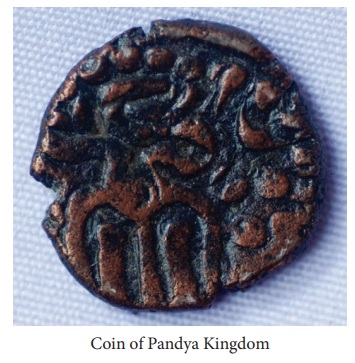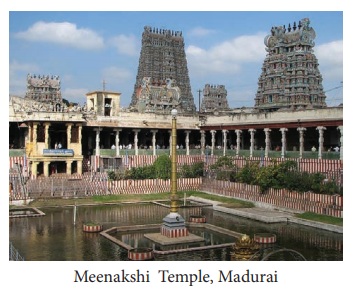Emergence of New Kingdoms in South India | Term 1 Unit 3 | History | 7th Social Science - The Later Pandyas | 7th Social Science : History : Term 1 Unit 3 : Emergence of New Kingdoms in South India: Later Cholas and Pandyas
Chapter: 7th Social Science : History : Term 1 Unit 3 : Emergence of New Kingdoms in South India: Later Cholas and Pandyas
The Later Pandyas
The
Later Pandyas
Introduction
Pandyas
were one of the three ancient Tamil dynasties that ruled southern India since
the 4th century B.C. (BCE) but intermittently. Korkai, associated with pearl
fisheries, is believed to have been their early capital and port. They moved to
Madurai later, as many early Tamil inscriptions of Pandyas have been unearthed
in Madurai and its surroundings. Under the Pandya kings of the Sangam Age,
Madurai was a great centre of culture. Poets and writers of Tamil language
gathered there and contributed to the development of Tamil Classics. The
Pandyas had re-established their strong position in south Tamil Nadu by the end
of the 6th century A.D. (CE), after eliminating the rule of Kalabhras. But they
could not resist the rising power of the later Cholas who ruled South India
from 9th to 13th century. Thereafter taking advantage of the decline of Chola
power,t he later Pandyas re-established their
authority. Their
rule continued until 16th century.
Revival of Pandya Kingdom
(A.D. (CE)
600 - 920)
Kadunkon
recovered Pandya territory from the Kalabhras towards the close of 6th century.
He was succeeded by two others. Arikesari Maravarman was the first strong
Pandya ruler who ascended the throne in A.D. (CE) 642. He was a contemporary of
Mahendravarman I and Narsimahvarman I. Inscriptions and copper plates praise his
victory over his counterparts: Cheras, Cholas, Pallavas and Sinhalese.
Arikesari Maravarman is identified with the Kun Pandian, the persecutor of
Jains.
Saivite saint Thirugnanasambandar converted Arikesari from
Jainism to Saivism. On his conversion, Arikesari is alleged to have impaled
around 8000 Jains on stakes. Though the number is an exaggerated one, the
anti-Jain attitude of Arikesari after his conversion to Saivism cannot be
doubted.
After
Arikesari, the greatest of the dynasty was Jatila Parantaka Nedunjadayan
(Varaguna I) (756-815),
the donor of the Velvikkudi plates. Nedunjadayan expanded the Pandya territory
to include Thanjavur, Tiruchirappalli, Salem and Coimbatore districts.
Nedunjadayan’s successors Srimara Srivallabha and Varaguna II, were successively
defeated by Pallavas. Later they could not face the rising Chola dynasty under
Parantaka I. Parantaka I defeated the Pandya king Rajasimha II who fled the
country in 920. Thus ended the Pandya rule revived by Kadungon.
Rise of Later Pandyas (1190
- 1310)
The
Chola viceroyalty became weak in Pandya country after the death of Adhirajendra
(the last king of Vijayalaya line). Eventually the Pandya kingdom could emerge
as the only leading Tamil dynasty in the 13th century. Madurai continued to be
their capital. Now Kayal was their great port. Marco Polo, a famous traveller
from Venice, visited Kayal twice, in 1288 and 1293. He tells us that this port
town was full of ships from Arabia and China and bustling with business
activities.
Marco Polo hailed the Pandyan Kingdom as ‘the richest and the
most splendid province in the world’. Together with Ceylon, he added, it
‘produced most of the gems and pearls that are found in the world’. In his
travel account he recorded the incidents of sati and the polygamy
practiced by the kings.
Sadaiyavarman
Sundarapandyan
The
illustrious ruler of the second Pandya Kingdom was Sadaiyavarman (Jatavarman)
Sundarapandyan (1251 to 1268). He brought the entire Tamil Nadu under his rule,
which extended up to Nellore in Andhra. He held the Hoysalas in check. The
Chera ruler, the chief of Malanadu, accepted his feudatory position and
paid tribute to Sundarapandyan. Emboldened by the decline of the Chola
state, the Boja King of Malwa region Vira Someswara challenged Sundarapandyan.
In a war at Kannanur, Sundarapandyan defeated Someswara. Sundarapandyan
succeeded in establishing his authority over the chieftains of Cuddalore,
Kanchipuram
in northern Tamil Nadu, Arcot and Salem in the western region.

There were two or three co-regents who ruled
simultaneously along with Sundarapandyan: VikramaPandyan and ViraPandyan. After
Sundarapandyan, Maravarman Kulasekaran ruled successfully for a period of 40
years , giving the country peace and prosperity. He had two sons. The king’s
appointment of ViraPandyan as a co-regent provoked the other son Sundara
Pandyan who killed his father Maravarman Kulasekaran. In the civil war that
ensued, ViraPandyan won and became firmly established in his kingdom. The
defeated SundaraPandyan fled to Delhi and took refuge under the protection of
Ala-ud-din Khalji. This provided the opening for the invasion of Malik Kafur.
After
Malik Kafur’s invasion, the Pandyan Kingdom came to be divided among a number
of kings from the main ruling Pandya’s family. In Madurai, a Muslim State
subordinate to the Delhi Sultan came to be established.
Polity and Society
State
Pandya
kings preferred Madurai as their capital. Madurai has been popularly venerated
as Koodal. The kings are traditionally revered as Koodal-kon, Koodal
Nagar Kavalan. The Pandyas derived military advantage over their neighbours
by means of their horses. They imported these horses through Arabs with whom
they had commercial and cultural contact.
The
king claimed that he was ruling according to Manu Sastra. This doctrine
supported the social hierarchy in the society. Kings and local chiefs created
Brahmin settlements called Mangalam or Chatur-vedi-mangalam with
irrigation facilities. The actual landowning groups are described as the
Bumiputtirar, otherwise called the vellalar. Historically they
were locals and hence they were referred to as nattu-makkal. The
communal assembly of this group is Cittira Meli Periyanattar.
Royal Officials
A
band of officials executed the royal orders. The prime minister was
uttara-mantri. The historical personalities like Manickavasagar, Kulaciraiyar
and Marankari worked as ministers. The royal secretariat was known as eluttu-mandapam.
The most respected officials were maran-eyinan, sattan-ganapathy,
enathi-sattan, tira-tiran, murthi-eyinan and others.
The titles of military commanders were palli-velan, parantakan-palli-velan,
maran-adittan and tennavan-tamilvel.
Administrative Divisions
Pandy
nadu, as in Chola state, consisted of many provinces known as vala-nadus,
which, in turn, were divided into many nadus and kurrams. The
administrative authorities of nadus were the nattars. Nadu and Kurram contained
settlements, viz. mangalam, nagaram, ur and kudi, where
different social groups inhabited.
Village Administration
An
inscription from Manur (Tirunelveli district) dated A.D. (CE) 800 provides an
account of village administration. It looks similar to Chola’s local governance
that included village assemblies and committees. Both civil and military powers
seem to have been vested in the same person.
Irrigation
The
Pandya rulers created a number of irrigation sources. On either side of the
rivers Vaigai and Tamiraparani, channels leading to the irrigation tanks
were built. In southern Tamilnadu, like the Cholas, Pandyas introduced the new
irrigation technology. Irrigation works were done by local administrative
bodies, local chiefs and officials. Repairs were mostly undertaken by local
bodies. Sometimes, traders also dug out tanks for irrigation.
Religion
Pandyas
extended patronage to vedic practices. Velvikkudi copper plates as well as
inscriptional sources mention the rituals like Asvameda yaga, Hiranya garbha
and Vajapeya yaga, conducted by every great Pandya king. The impartiality of
rulers towards both Saivism and Vaishnavism is also made known in the
invocatory portions of the inscriptions. Temples of both sects were patronised through land grant,
tax-exemption and renovation.
The
great Saiva and Vaishnava saints (Nayanmaras and Alwars) combined contributed
to the growth of Tamil literature and spiritual enlightenment. The period was
marked by intense religious conflict. The Bhakti movement of the time prompted
the heterodox scholars for a debate. Many instances of the defeat of Buddhists
and Jains in such debates are mentioned in Bhakti literature. The Pandya kings
of the period supported and promoted Tamil and Sanskrit.
Temples
Medieval
Pandyas and later Pandyas did not build any new temples but maintained the
existing temples, enlarging them with the addition of gopuras, and mandapas.
The monolithic mega size ornamented pillars are the unique feature of the
medieval Pandya style. The sculptures of Siva, Vishnu, Kotravai, Ganesa and
Subramanyar are the best specimens in these temples. Pandyas specially
patronised the historic Meenakshi temple at Madurai and kept expanding its
premises by adding gopuras and mandapas.

Trade
Arab
settlements on the west coast of southern India, from 7th century, had led to
the expansion of their trade connection to the east coast because the
governments of the east coast pursued a more liberal and enlightened policy
towards overseas traders. Their charters exempted traders from various types of
port dues and tolls. In Kayal, there was an agency established by an Arab
chieftain by name Malik-ul-Islam Jamal-ud-din. This agency facilitated
availability of horses to Pandya kings.
In
13th and 14th centuries, horse trade became brisk. Marco Polo and Wassaff state
that the kings invested in horses as there was a need of horse for ceremonial
purposes as well as for fighting wars. Those who were trading in horses were
called kudirai chetties. They were active in maritime trade also. The
busiest port town under the Pandyas was Kayal Pattinam (now in
Thoothukudi district) on the east coast. Gold coins were in circulation as the
trade was carried through the medium of gold. It was variously called kasu,
kalanchu and pon.
The vast trade in horses of that time has been recorded by
Wassaff. He writes: ‘…as many as 10,000 horses were imported into Kayal and
other ports of India of which 1,400 were to be of Jamal-ud-din’s own breed. The
average cost of each horse was 220 dinars of “red gold’.
Summary
•
The Cholas and Pandyas are well known Tamil monarchs.
•
Vijayalaya revived the Chola dynasty.
•
The prominent Chola rulers are Rajaraja I and Rajendra I.
•
Uttiramerur inscriptions provide details of village administration.
•
Kodunkon recovered Pandya territory from Kalabhras. Arikesari Maravavarman and
Parantaka Nedunjadayan were his two prominent successors.
•
The illustrious rulers of later Pandya kingdom were Sadaayavarman
Sundarapandyan and Maravarman Kulasekaran.
•
Maritime trade during Pandyas is highlighted by Marco Polo and Wassaff.
Glossary
1.
Matrimonial alliances: political
alliances through marriages திருமண
உறவுகள் மூலம்
அரசியல் கூட்டு
2.
Embankment: a wall or stone
structure built to prevent a river flooding an area as well as to store its
water தடுப்பணை
3.
Ardent: passionate தீவிரமான
4.
Feudatory: a subordinate to
another sovereign/ruler அரசருக்குக்
கட்டுப்பட்ட
குறுநில மன்னர்
5.
Refuge: shelter புகலிடம்
6. Repository: place in which things are stored கருவூலம்
References
1. K.A Nilakanda Sastri, A History of
South India, New Delhi: Oxford University Press, 2002.
2. Y. Subbarayalu, South India under
The Cholas, New Delhi: Oxford University Press, 2012.
3. R Champakalakshmi, Trade, Ideology
and Urbanization South India- 300 BC to AD 1300, New Delhi: Oxford University
Press, 1996.
4. Satish Chandra, History of Medieval
India, New Delhi: Orient Blackswan, 2010.
Related Topics